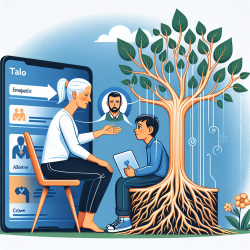As a practitioner focused on creating great outcomes for children, it is essential to continually improve your skills and knowledge base. A recent study titled "Establishing a novel partnership model to deploy health services for children with autism in a low-resource setting – experience from Sri Lanka" offers valuable insights that can be applied in various contexts, including online therapy services provided by TinyEYE.
The study describes the establishment of an Autism Center in Northern Sri Lanka, using a partnership-based public/non-governmental organisation/charity model. This model can be particularly useful in low-resource settings, where financial and human resources are limited. Here are some key takeaways and practical steps for implementing these insights into your practice:
Key Takeaways from the Study
- Partnership Model: The study highlights the effectiveness of a partnership model that incorporates state institutions, local and international charity organizations, and volunteers. This approach ensures the sustainability of funding and resources.
- Governance Structure: A simple and flexible governance structure under the administrative umbrella of the Regional Directorate of Health Services was crucial. This included an advisory body consisting of technical experts, administrators, staff members, and parents.
- Training and Development: Initial training and continuous professional development for staff were critical for the Center's success. This included both local and international training programs.
- Data-Driven Approach: The Center maintained a robust documentation system to track assessments, therapy goals, interventions, and progress. Regular data analysis facilitated continuous improvement.
Practical Steps for Practitioners
- Form Partnerships: Consider forming partnerships with local schools, healthcare providers, and non-profit organizations to pool resources and expertise.
- Establish Governance Structures: Implement a governance structure that includes an advisory board with diverse stakeholders, including parents and technical experts.
- Focus on Training: Invest in initial and ongoing training for your staff. Utilize online courses, webinars, and partnerships with educational institutions to ensure your team is well-equipped.
- Implement a Data-Driven Approach: Develop a comprehensive documentation system to track each child's progress. Regularly analyze this data to identify areas for improvement and to make informed decisions.
By adopting these strategies, practitioners can enhance the quality of care provided to children with autism, even in low-resource settings. The success of the Autism Center in Sri Lanka demonstrates that with the right partnerships and a data-driven approach, significant improvements can be made.
To read the original research paper, please follow this link: Establishing a novel partnership model to deploy health services for children with autism in a low-resource setting – experience from Sri Lanka.










